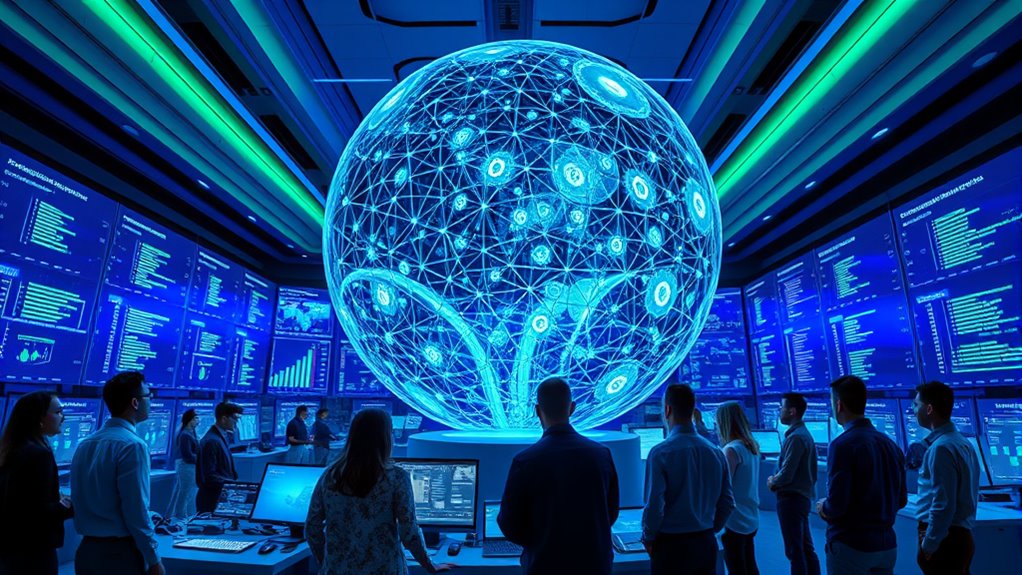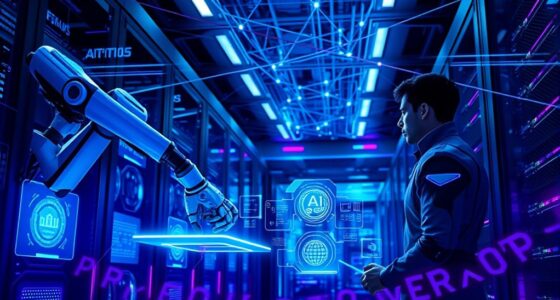Emerging trends in AI-powered development focus on integrating explainable AI and automated code generation to build more transparent, efficient, and trustworthy applications. You’ll see advancements in ensuring fairness, security, and regulatory compliance within AI systems, helping you create responsible solutions. These innovations streamline workflows, reduce errors, and foster stakeholder confidence. Staying current means you’ll better adapt to evolving tools and practices—so, explore further to discover how these trends can elevate your development projects.
Key Takeaways
- Increasing integration of Explainable AI (XAI) to enhance transparency and stakeholder trust in AI systems.
- Adoption of AI-driven automated code generation to accelerate development and ensure consistency.
- Emphasis on AI security and regulatory compliance to protect data and meet legal standards.
- Development of hybrid models combining interpretability with high performance for complex tasks.
- Growth of AI-powered development tools that streamline workflows and improve application quality.

As artificial intelligence continues to evolve at a rapid pace, it’s transforming the way developers build and deploy applications. One of the most exciting trends is the rise of Explainable AI, which aims to make AI decision-making transparent and understandable. Instead of treating AI as a black box, you’re now able to gain insights into how models arrive at specific conclusions, which is vital for debugging, compliance, and building trust with users. Explainable AI tools help you interpret complex models like deep neural networks, allowing you to see the factors influencing predictions. This transparency not only enhances your confidence in deploying AI solutions but also streamlines collaboration with stakeholders who need to understand the rationale behind automated decisions. As a developer, you’re empowered to create more responsible and ethical AI applications by incorporating explainability features from the outset. Supporting this, understanding the individual responses of models can help tailor solutions to better meet user needs and ensure fairness in AI systems. Additionally, advancements in model interpretability are making it easier to identify biases and improve model robustness, further strengthening your AI applications. Incorporating AI security measures into these models is essential to safeguard sensitive data and prevent malicious exploitation, especially as cyber threats become more sophisticated. Moreover, integrating regulatory standards into AI development processes is increasingly important to ensure compliance with evolving legal frameworks.
Alongside this, Automated Code Generation is revolutionizing your workflow. Instead of writing every line manually, you can leverage AI-powered tools that generate code snippets, functions, or even entire modules based on high-level descriptions. These tools analyze your requirements, suggest optimized code, and sometimes even learn from your coding style to produce more tailored outputs. This automation accelerates development cycles, reduces human error, and frees you up to focus on higher-level design and problem-solving. You no longer need to spend hours on boilerplate or repetitive tasks; instead, you can use AI to handle those parts, ensuring faster delivery without compromising quality. Automated Code Generation also promotes consistency across projects, making maintenance easier and reducing technical debt over time. As these tools become more sophisticated, they are increasingly capable of understanding complex project contexts, further enhancing your productivity.
Combining Explainable AI with Automated Code Generation creates a powerful synergy. You can generate AI models and algorithms that are not only effective but also interpretable, helping you meet regulatory standards and build user trust. When deploying these models, you can explain their outputs to stakeholders or end-users clearly, fostering transparency and understanding. This integration supports a more responsible AI development process, where efficiency and ethics go hand in hand. As you adopt these emerging trends, you’ll notice how they streamline your workflows, improve the quality of your applications, and prepare you for a future where AI-driven development becomes even more integral. Staying ahead means embracing these innovations now, so you can build smarter, more transparent, and reliable AI-powered applications with ease.
Frequently Asked Questions
How Will AI Impact Software Development Job Roles?
AI will substantially impact your software development job roles by automating code generation, allowing you to focus on more complex tasks. You’ll need to adapt by enhancing your AI skill requirements, understanding how to integrate AI tools effectively. As automation handles routine coding, your role shifts toward overseeing AI outputs, troubleshooting, and innovative problem-solving. Embracing these changes will make you more efficient and valuable in the evolving tech landscape.
What Are the Ethical Considerations in Ai-Powered Development?
When you develop AI-powered systems, you must consider ethical issues like bias mitigation and data privacy. You’re responsible for ensuring your algorithms don’t perpetuate unfair biases and that user data stays protected. By actively addressing these concerns, you build trust with users and create more equitable technology. Prioritize transparency and accountability to prevent harm, and stay updated on evolving regulations to maintain ethical standards in your AI development process.
How Can Small Businesses Leverage AI Development Trends?
Think of AI development trends as a treasure map for small businesses. You can *uncover* new growth by leveraging small business automation, streamlining operations, and cutting costs. AI customer service tools help you provide 24/7 support, boosting customer satisfaction. By embracing these trends, you turn technology into your trusted compass, guiding your business to stay competitive and innovative in a rapidly evolving market.
What Are the Security Risks Associated With AI Integration?
When you integrate AI, you face security risks like data privacy breaches and algorithm bias. You might accidentally expose sensitive information or rely on biased algorithms that affect decision-making. To protect yourself, guarantee strict data privacy measures and regularly audit your AI systems for bias. Being proactive helps you mitigate risks, maintain trust, and ensure your AI deployment remains secure and fair.
How Will AI Influence Future Programming Languages?
AI will be the compass guiding future programming languages, steering their design towards smarter, more intuitive code. You’ll see AI influence language design by automating code optimization, making development faster and more efficient. It’s like giving programmers a new set of tools, enabling them to craft cleaner, more effective code. As AI’s role grows, you’ll find your coding evolving into a seamless dance of human creativity and machine intelligence.
Conclusion
As you embrace these emerging AI trends, you open new possibilities, ignite innovation, and drive transformation. You adapt to change, leverage opportunities, and overcome challenges. You harness AI’s potential, shape the future, and make a difference. Stay curious, stay bold, and stay committed. Because in this rapidly evolving landscape, your actions today will define tomorrow’s success. Embrace the future of AI-powered development, and let your vision lead the way.









